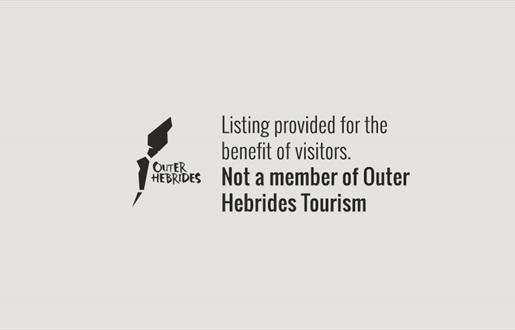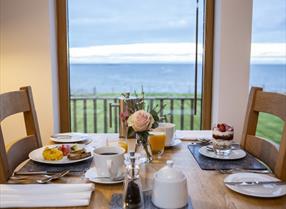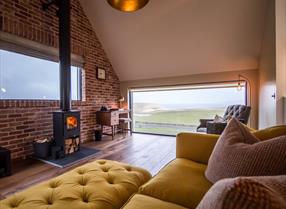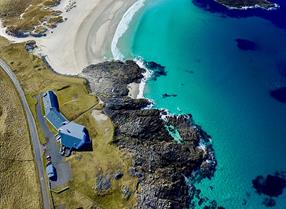South Uist
Experience some of the best that the islands’ outdoors has to offer at Loch Druidibeg on the west side of South Uist. Here fans of horticulture can explore the abundance of plant life, while ornithologists can find ample opportunities for birdwatching, with chances to spot species such as redshank, dunlin, lapwing and greylag geese.
Explore the heights of the Hebrides on South Uist's east side, where hillwalking opportunities include the peaks of Hecla, Beinn Mhor, Beinn Corradale and Ben Kenneth, with gentler trails available at ground level for those wishing to explore without the exertion! More walking trail information here.
Follow in the footsteps of South Uist’s first settlers with a trip to the island’s south end, where Hebridean hospitality awaits on the shores that welcomed early incomers to the area.
The East Side of South Uist is the perfect place to explore, with a wide range of walks and routes providing the perfect opportunity to uncover all that area has to offer.
Locheynort, Lochboisdale, South Lochboisdale, and Lasiger all provide great starts to your East North Uist journey of discovery with a range of Hebridean highlights on offer within easy reach of each location.
Leave from Locheynort and pursue the coastal path to spot otters and sea eagles, or head to Loch Skiport where a walk from the end of the road is also wonderful for wildlife watching.
Challenge yourself with hillwalk on Hecla, Beinn Corrodale and Beinn Mhor - whose summits offer breathtaking panoramas over the inlets and bays that characterise the island’s east coast , or climb to the top of Ben Kenneth and look out over Lochboisdale.
From Lochboisdale, which also serves as the island’s ferry terminus, take the circular path via Laisger before returning to your starting point where you can find all your creature comforts including shops, banking, post office and cafe – as well as a community garden and kids play park. There are regular sailings from here to and from Castlebay on Barra or Oban on the mainland.
Alternatively head for South Lochboisdale with its traditional thatched cottages providing an appealing aesthetic that is only enhanced by the nearby Listening Place a Road Ends project sculpture that forms part of the Uist Sculpture Trail.
This intriguing installation by Valerie Pragnell celebrates the links between the area’s crofting and lyrical traditions, with verses from celebrated local poets engraved in the stone built structure which also incorporates tractor seats for visitors to stop and listen to the story of the land.
The West Side of South Uist encompasses everything that embodies an Outer Hebridean holiday – from stunning natural surroundings to a rich and diverse island history peopled with colourful characters.
One of the most famous natives must be the Jacobite heroine Flora Macdonald, who bravely spirited Bonne Prince Charlie away over the sea to Skye as he fled following the bloody battle of Culloden. Reputedly born near the tiny hamlet of Milton in 1722, her memory is now marked by a cairn standing near the ruins of an 18th Century settlement which archaeological excavations reveal to have included blackhouses and a corn drying kiln.
Archaeologists have been hard at work all over the West Side of the island, and nowhere more so that in the Machair at Daliburgh, where studies have revealed that 19 of the surrounding sand hills were actually ancient settlements – the oldest of which at Cladh Hallan dates back to the early bronze age.
Another significant site is Teampul Mor at Howmore, where visitors can wander among the ruins of a 13th Century chapel at what was once an important place of island worship.
Howmore itself is also well worth a visit. This little village is home to one of Scotland’s best collections of thatched cottages, providing a truly picturesque welcome to the weary traveller. The Howmore hostel is housed in one of these traditional buildings, while the village is also home to providers of cycle hire for those who prefer to explore under pedal power – own transport really is essential as visitors who attempt to board the buses often parked by the side of the road will be sorely disappointed as these are veteran vehicles restored for display purposes!
The South End of South Uist epitomises unspoiled with numerous white sand beach coves looking across the shallow waters and sands towards neighbouring Eriskay, which can be accessed from here by causeway.
Visit the prehistoric Polachar Stone – a monolithic monument believed to have originally marked the site of an ancient landing spot on the island’s shore – signposting the way for the early settlers in the south.
Dating from 2000 BC, the stone stands more that 1.7 metres tall against the stunning backdrop of sea and sky and as the sun sets, casts the shadow of the past on the landscape of the present.


















